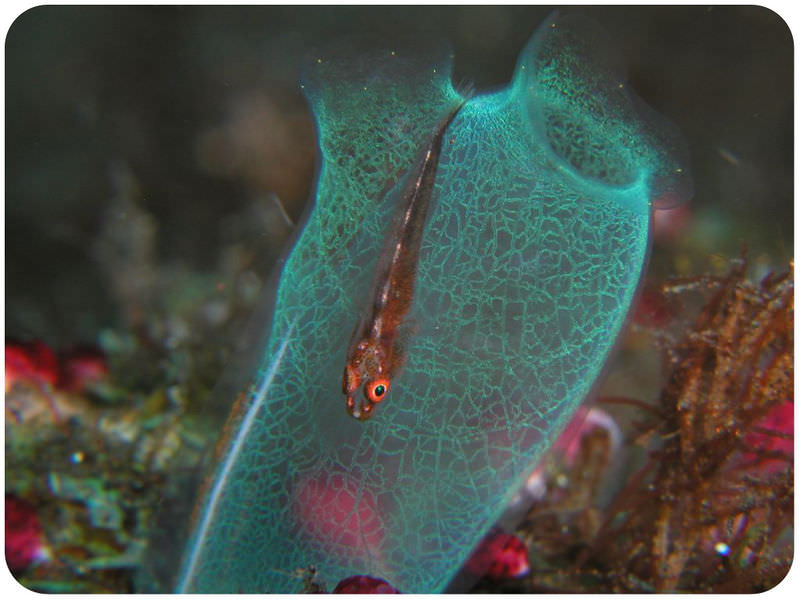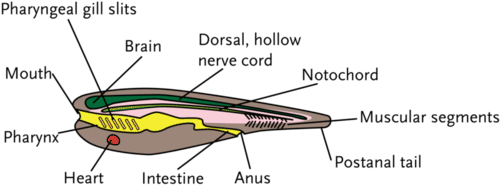10.1 Chordates
10.1 Chordates
What do these two animals have in common with you?
Notice the orange fish. Around him is another type of animal, a tunicate, in blue. Tunicates, fish, and humans seem very different from one another, but they do have some things in common. They are all chordates.
Chordates
Did you know that fish, amphibians, reptiles, birds, and mammals are all related? They are all chordates. Chordates are a group of animals that includes vertebrates, as well as several closely related invertebrates. Chordates (phylum Chordata) are named after a feature they all share, a notochord. A notochord is a hollow nerve cord along the back.
Characteristics of the Chordates
Chordates are defined by a set of four characteristics that are shared by these animals at some point during their development. In some chordates, all four traits are present in the adult animal and serve important functions. However, in many chordates, including humans, some traits are present only during the embryonic stage. After that, these traits may disappear.
All chordates have four main traits (Figure below):
- Post-anal tail: The tail is opposite the head and extends past the anus.
- Dorsal hollow nerve cord: "Dorsal" means that the nerve cord runs along the top of the animal. In some animals, the nerve cord develops into the brain and spinal cord.
- Notochord: The notochord lies below the nerve cord. It is a rigid structure where muscles attach.
- Pharyngeal slits: Pharyngeal slits are used to filter out food from water by some simple chordates. In most chordates, however, they are only present during the embryonic stages and serve no apparent purpose.
Body Plan of a Typical Chordate. The body plan of a chordate includes a post-anal tail, notochord, dorsal hollow nerve cord, and pharyngeal slits.
Classification of the Chordates
The chordates are divided into nine classes. Five of the classes are the fish, amphibians, reptiles, birds, and mammals. There are actually five classes of marine chordates (for example, sharks are cartilaginous fish which are distinct from bony fish), and these will be discussed in additional concepts.
The chordate phylum is broken down into three subphyla:
- Urochordata: The tunicates, pictured in the introduction, make up this group. The urochordates are sessile (non-moving) marine animals with sack-like bodies and tubes for water movement. Urochordates have a notochord and nerve cord only during the larval stage.
- Cephalochordata: Cephalochordates include the lancelets (Figure below), fish-like marine animals often found half-buried in the sand. Cephalochordates have a notochord and nerve cord but no backbone.
- Vertebrata: Humans and other mammals, along with fish, amphibians, reptiles, and birds, fall in this category. In vertebrates, the notochord is typically smaller and surrounded by a backbone.
The lancelet, an example of a chordate, is found in shallow ocean waters.
Summary
- Chordates are animals that have a notochord, post-anal tail, dorsal hollow nerve cord, and pharyngeal slits.
- Chordates include all vertebrates and some invertebrates.
Explore More
Use the resource below to answer the questions that follow.
(Note: this resource refers to human embryos as having gill slits. This is a commonly held misconception which seems to have originated in a now defunct theory by Ernst Haeckel. In the embryonic development of chordates, there is a stage where an invagination, called "gill pouches" or "pharyngeal pouches," appear in vertebrate embryos. This invagination does develop into gills in some species, but in other species the invagination develops into other structures. So, while parallels in the development of chordates are accurate, it is misleading to say human embryos have gill slits. You can find out more here http://www.angelfire.com/journal/Philsviews/Science/embryo.html.)
- Chordate Animation: Amphioxus to Vertebrate Body Plan at http://vimeo.com/37411858 (1:31)
- What does the nerve cord in Amphioxus do?
- What is a notochord, and what characteristics does it give Amphioxus?
- What signs of a notochord do we see in human beings (Homo sapiens)?
- What is the relationship of the vertebrate backbone to the vertebrate skeleton?
Review
- What is the main common feature of all chordates?
- Name three examples of chordates.
- List three characteristics of chordates.
- What is the dorsal hollow nerve cord?
- Log in or register to post comments
- Email this page



